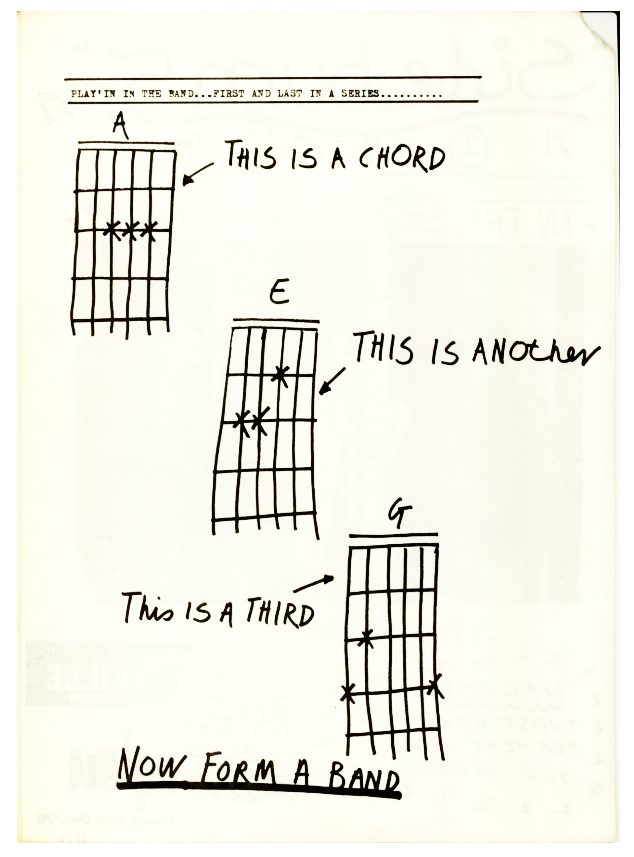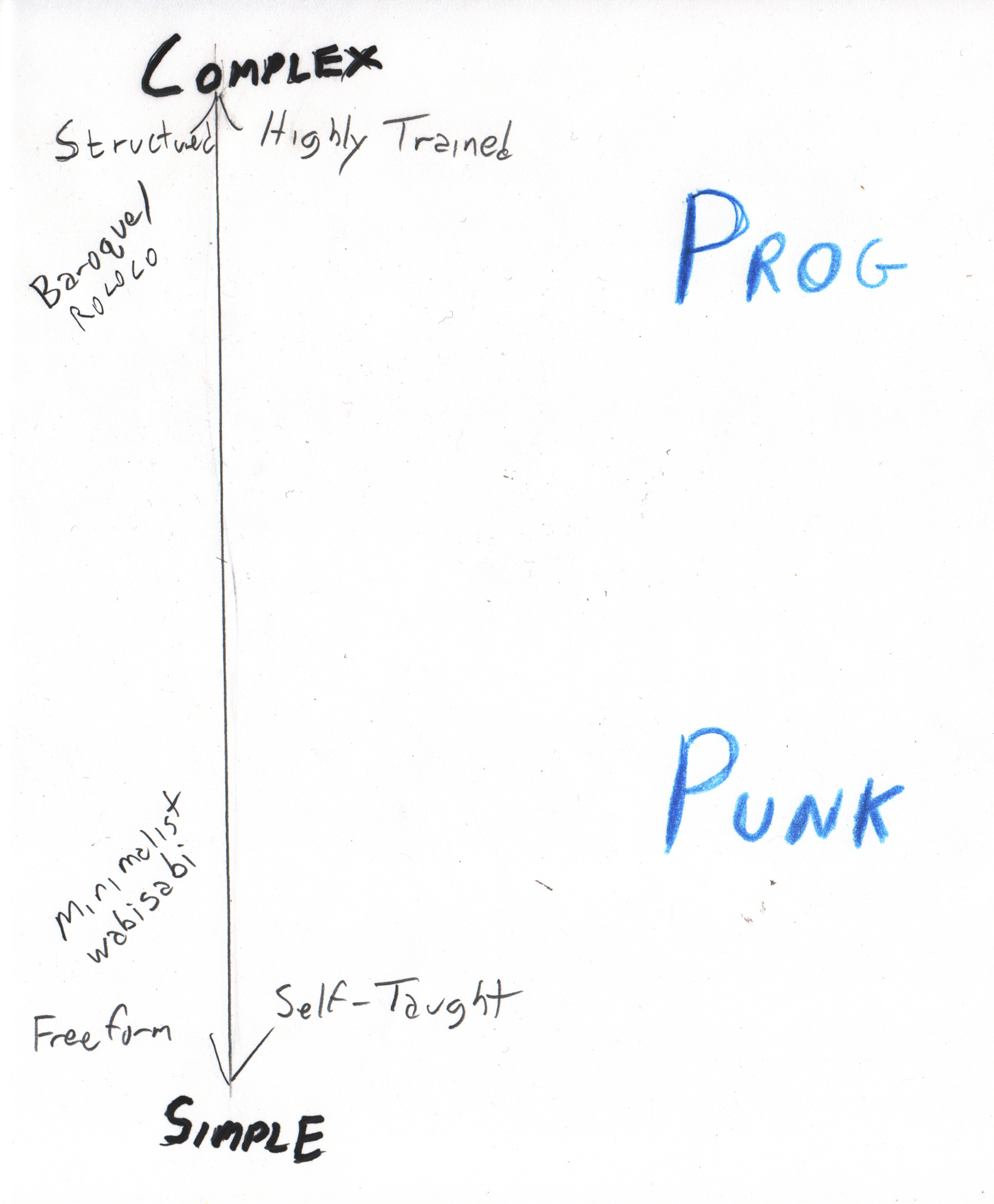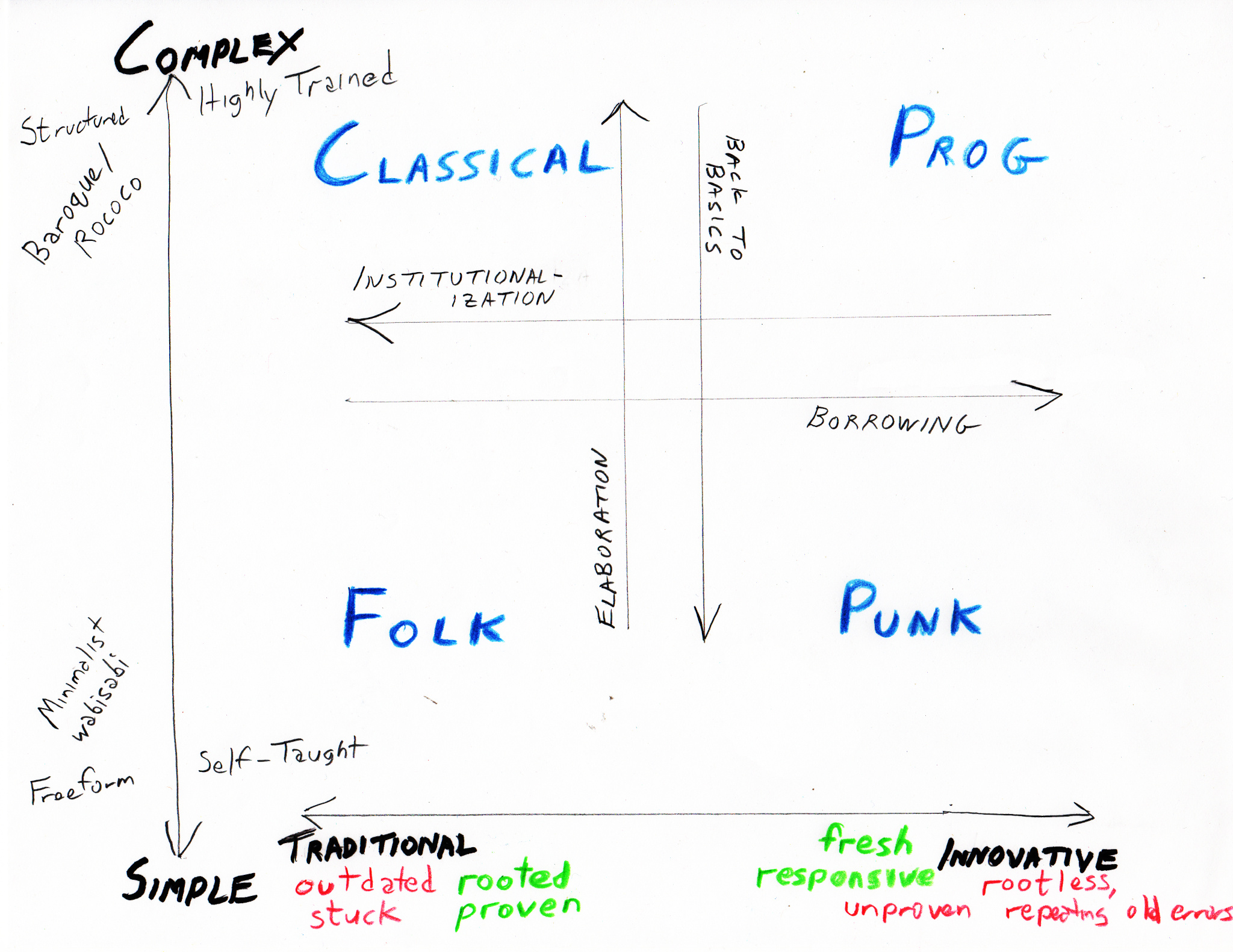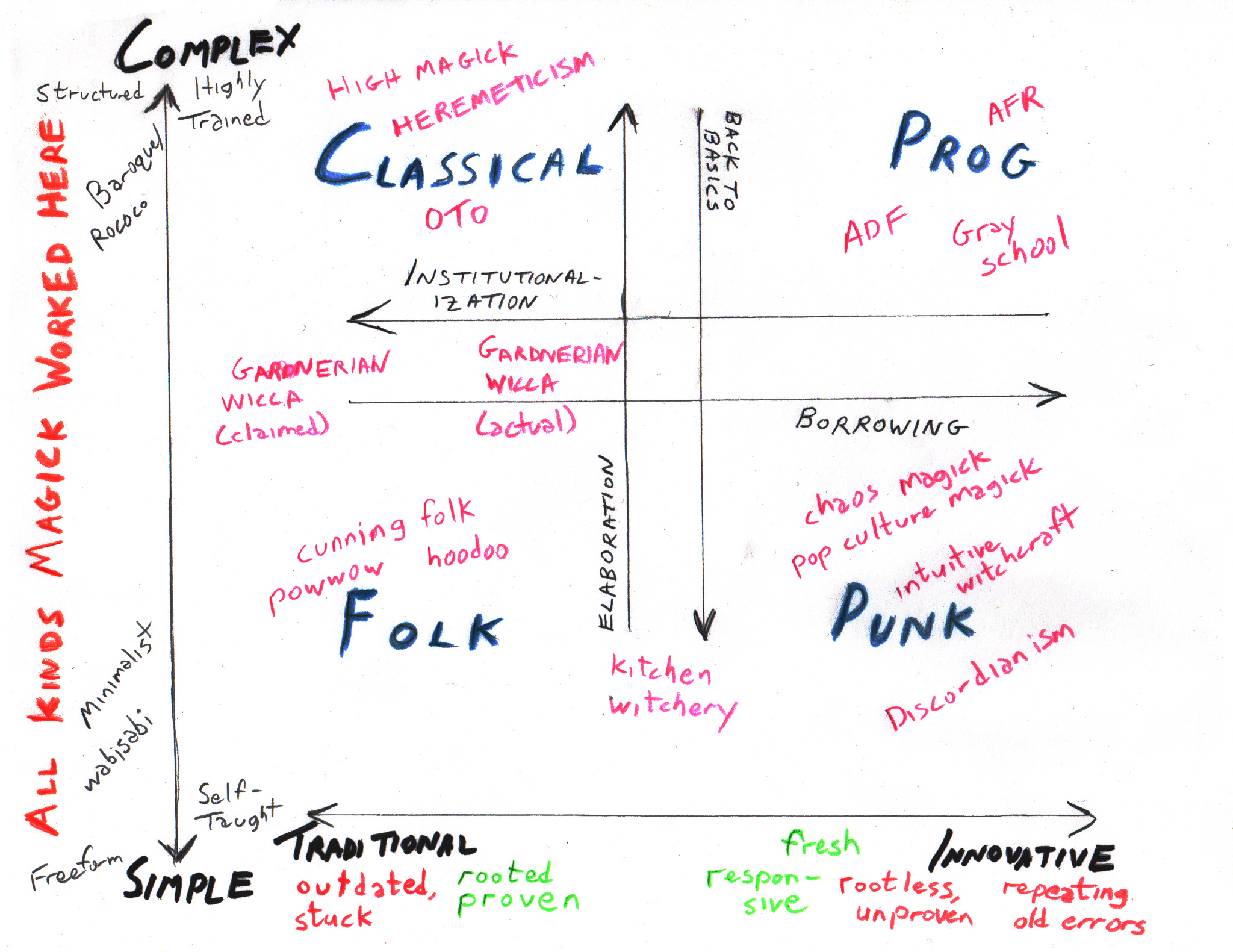"...Magic is an art / Worked with will and from the heart" -- Doktor Billy Bardo
A lot of our ideas about magic can be traced to the 19th century, when some upper-class European and American people involved in movements like Theosophy and Freemasonry started using ritual magic as a tool for spiritual development.
These were people who could afford to purchase lots of books and elaborate ritual tools, set aside and furnish special rooms for magical work, and devote leisure time to obscure studies and extended magical workings.
But what if you don’t have those sort of resources?
For inspiration I’d like to look at an artistic movement that made a virtue out of a lack of resources: punk rock.
In the 1970s, as punk was developing, the zine Sideburns featured a cartoon showing three guitar chord shapes, with the words “This is a chord. This is another. This is a third. Now form a band.”

This is a fantastic summary of the punk approach to music: strip the art down to its absolute bare essentials, and go forward confidently, with a “do it yourself” spirit to engage directly with it.
In contrast, we have progressive or “prog” rock. Rather than stripping things down, prog rock added complex orchestration – the sort of thing you usually find in classical music rather than rock and roll – and lots of production in the studio.
In every art, we can find these two trends: adding on, and striping away.
In live theater you’ve got elaborately staged musicals and you’ve got plays meant to be staged in minimalist “black box” theaters. (Or even, in the age of COVID-19, staged on-line with the actors in their own homes.)
Poems range from multi-volume epics with complex patterns of rhythm and rhyme, to brief haiku, or works of “prose poetry” in a very natural language.
Painting can be hyper-realistic, or can try to capture the essence of a scene on a few brushstrokes.
One trend to build up and elaborate, the other to simplify and get back to the fundamentals. Baroque versus wabi-sabi.
Part of it is economics: elaborate works require more materials and/or time. Indeed, sometime elaboration is just conspicuous consumption, meant to show off the artist’s patron’s resources. Likewise sometimes the simple, wabi-sabi approach is just people of limited resources doing their best, not an aesthetic choice.
But there are rich kids who are into simple styles, and starving conservatory students who are devoting their lives to elaborate forms of art. Over time, the aesthetic factor dominates the socioeconomic ones.
We could be fancy and call these processes of elaboration and simplification “anabolic” and “catabolic” processes. But I’m a rock and roller, and I like to think of them as “prog” and “punk”.

Neither of these is better than another! They are two parts of a cycle, a yin and yang pairing. But a person’s taste will usually run more to one than to the other.
To really get the picture we have to add a second axis, of tradition versus innovation. Traditional forms may be rooted in time and proven by experience but they can also be outdated or stuck in time. Innovative forms can have fresh ideas and be responsive to changing circumstances but are unproven and may ignore history and repeat old errors.
Then we have Four Quadrants of Art: Classical, Folk, Prog, and Punk.
Our diagram has currents running up and down, left and right. Elaboration turns punk to prog, or folk to classical; back-to-basics goes the other way.

Institutionalization makes new things traditional over time, so prog becomes classical and punk becomes folk. Borrowing runs the other way, new forms borrow from traditional ones.
Always remember that the map is not the territory! This is just a model to help us get started in our thinking, and we must drop it when it starts to get in the way. With that in mind, let’s think about where some various schools, styles, and magical/religious groups go on the chart.
We already mentioned the ritual magic of 19th century occultists, the Hermetic – Golden Dawn – Aleister Crowley sort of magic. Elaborate stuff.
And there’s a general trend in that sort of occultism to look backwards, trying to find that Ancient Hidden knowledge. There’s often an underlying assumption that the past was more magical. (A bad assumption!)
So traditional and complex – classical. We put that stuff in the upper left.
The 20th century saw the rise of modern witchcraft, especially Gerald Gardner’s Wicca. This sort of witchcraft is sometimes called “low magic” to contrast it with the “high magic” of elaborate ritual.
But while Wicca and the spiritual paths that derived from it have some roots in folk magic – magic for the masses! Power for the people! -- they were still influenced by the Hermetic tradition. They have a hierarchical structure with various degrees of initiation and formalized teacher and student roles. And Garner’s narrative – which, let’s be clear, has been pretty much debunked – is that he was reviving an ancient tradition that had been kept secret.
So maybe we should give Uncle Gerald two spots on our graph here, for the ancient tradition somewhere near the border of classical and folk he claimed to be doing, and one further to the right for the innovative synthesis he was sneaking in.
At the bottom left we have folk magic. It’s traditional but doesn’t need anything complicated. There’s not a lot of formal history to it – just like all those folk song attributed to “Traditional”, these workings spread within communities by word of mouth rather than by being written down and published or taught in a formal curriculum.
So-called “Kitchen witchery” has a lot of traditional elements but also some looking to do new stuff. We’ll put them on the border between folk and punk. The details are debatable, these are just broad illustrations.
In the upper right we might put groups like ADF (Ár nDraíocht Féin: A Druid Fellowship), which have a formal structure and study programs, and which are explicit about trying to do something new even as they look to the past. Up here we might also put the Alchemical Fire Ritual tradition. Maybe the Gray School of Magic, another group trying to develop a new formal curriculum, would go up there too.
And all of these are fine and noble approaches.
But let’s direct our attention to the bottom right corner.
“Chaos Magick”, where the workings use a pretty simple sigilization – you can find sigil generators on-line – might go here. Pop culture magic, too.*
Discordianism – the Turkey Curse is pretty punk, as the the idea that every person on Earth is a Pope (someone not under the authority of the authorities) and that the way to become an official Episkopos of The Discordian Society is to declare yourself one.
A lot of what we see people doing under the label “intuitive witchcraft”, making up their own thing, would go here.

With this big picture to orient us, we can take the attitude towards magic that that famous Sideburns cartoon took towards music. Instead of three chords we’re going to boil magic down to an Easy Five Step Process, and send you out to Do It Yourself.
In fact, our first order of business ought to be to let you in on a secret:
You – yes, ***YOU*** – Are Already A Magician
In a lot of our myths and stories, we have an idea that magic is this very special thing that is only for some very special people who were born that way.
Harry Potter is a Prophesied Chosen One. So is Tim Hunter in Neil Gaiman’s The Books of Magic.
In Ursula LeGuin’s Earthsea novels, the wizardly protagonist Ged demonstrates his precocious magical power as young child, he’s a natural from the start.
In the Arthurian mythos Merlin inherits his powers from a demon father.
One of our best-known fictional wizards, Gandalf from The Lord of the Rings, isn’t even half-human – he’s something more like an angel given human form, created by that world’s god specifically to assist and guide mortals.
Now, literary conventions are useful. We know that in a mystery, the detective is destined to solve the case; in a romantic comedy we know that the couple will Live Happily Ever After. In an action movie we know that the bad guys will miss when they shoot at the hero, or a most give him a minor wound.
These conventions have entertainment value and orient us to the story, but they can also distort our understanding of crime, or romantic relationships, or combat, or whatever is the topic of the story.
So the same is true about magic. We have to be careful about what we learn from fiction about it. We have to drop the idea that magic is only for some special people. As Crowley put it, “Every man should make Magick the keynote of his life.” (We of course would expand that with gender-neutral language today.)
If we understand magic as “the art of changing consciousness at will”, then we all do it. We know that if we’re feeling sad, playing certain songs will change our consciousness to something less sad. If we’re going out on a date, we know that wearing a certain piece of clothing or jewelry, or a certain cologne or perfume, will make us feel sexy.
This is, in a very basic way, practicing magic on ourselves.